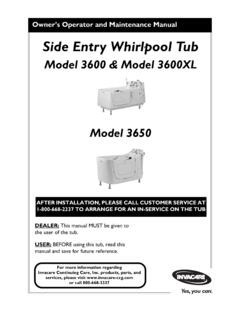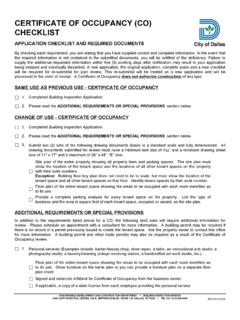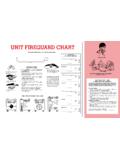Transcription of Grain Comfort Stove
1 1 Grain Comfort Stove Version: 2012 Certified to Burn - Corn Wheat and Rye Grain Stoves Inc.
2 #3 BLYTH, ONTARIO, CANADA Phone: (519) 523-9897 Fax: (519) 523-9222 Patent 1991-2009 5,105,797 CDN. 2,051,804 2 Dear Customer: Congratulations! You have just purchased the Grain Comfort Stove . Each part of your unit is of the highest quality of material and workmanship. We believe that once you begin using your heating unit, you will know that you have made a very wise decision in choosing the Grain Comfort Stove . The purpose of this manual is to help you get maximum enjoyment and heating efficiency from your unit. By following these instructions and suggestions, you can be assured years of safe and economical heating for yourself and your family. Thank you for buying your Grain Comfort Stove . Grain Stoves Inc. ** SAFTEY NOTICE ** If this Stove is not properly installed, there is a risk of fire.
3 For your safety, follow the directions given in this manual. Contact your local building or fire officials about restrictions and installation requirements specific to your area. The manufacturer assumes no responsibility for equipment installed in violation of either this manual or local codes or ordinances. 3 INDEX INTRODUCTION 4 HEATING SAFETY and SOLID FUEL 5 UNPACKING 6 CHECKLIST 6 FLOOR PROTECTION 6 INSTALLATION OVERVIEW 7 INSTALLATION CLEARANCES 7 FREE STANDING INSTALLATION 8 VENTING KIT 8 THROUGH WALL VENT INSTALLATION and DIMENSIONS 9 CORNER INSTALLATION 10 BASEMENT INSTALLATION 11 CHIMNEY VENT INSTALLATION 11 FIREPLACE INSPECTION 12 FIREPLACE PREPARATION 12 FIREPLACE CLEARANCES 12 SEALING THE Grain Comfort Stove 12 FIREPLACE INSTALLATION 13 ALTERNATIVE INSTALLATIONS 14 COMPONENT REFERENCE 14 OPERATIONAL FINAL CHECK 15 STARTING PROCEDURE 16 DAILY MAINTENANCE 19 MONTHLY MAINTENANCE 21 ANNUAL MAINTENANCE
4 23 CLEANING 24 CLEANING THE FIREBOX 25 SHUTDOWN 25 TROUBLESHOOTING 26 WARRANTY 27 OWNERS REGISTRATION 28 CUSTOMER SURVEY 29 SCHEMATIC 30 4 INTRODUCTION Your Grain Comfort heating system is designed, engineered and built to provide you with a safe, efficient heating unit. The Grain Comfort Stove is designed and engineered to burn Shelled Corn, Wheat and Rye. The Grain Comfort heating system has successfully undergone various safety and performance tests and is certified to the standards of UL, ULC, in Canada and United States. To realize all of the reliable service advantages that have been engineered into your Grain Stove and avoid voiding your warranty, you must follow all of the instructions contained in this manual. Before attempting to install or operate your Stove , you should familiarize yourself with the components and operating controls of the unit.
5 (PAGE 13) READ ALL INSTRUCTIONS BEFORE INSTALLING OR USING THE APPLIANCE. Throughout this handbook, you will see international caution signs beside a number of areas. They relate to safety, or some other important aspect you need to know. Please make special note of these areas. Read these instructions completely and carefully before installing your Grain Comfort unit and keep them for future reference. HEATING SAFETY and SOLID FUEL Certain safety hazards are inherent in any solid fuel unit installation. You should be aware of these, so that a safe and proper installation can be made. 1- Prior to building your first fire, the manufacturer recommends that your Grain Comfort installation be inspected by the local governing authority having the jurisdiction to assure that all code requirements have been complied with.
6 2- If such inspections are not possible, the owner should acquaint themselves with the following: National Fire Protection Association, Standard 211 1985 or the latest edition. Address of the NFPA is: Battery March Park, Quincy, MA 02269 or the National Building Code. 1986 edition of the Uniform Mechanical Code, Section 915. ULC 5627/CSA-B366-2M/APF 1 (on Aug. 2003) 3- Faulty Chimney: An older masonry chimney should be thoroughly checked to be sure there are no holes or weak spots which could allow sparks or hot gases to escape. 5 HEATING SAFETY and SOLID FUEL: con t 4- Heat Conduction: Placing combustible materials too close to the unit or chimney can be a fire hazard. 5- Chimney Installation: Use a spark arrester and a rain shield on your exhaust pipe. 6- Your shelled corn, rye and/or wheat should be clean and screened.
7 7- Use smoke detectors around the unit as well as in sleeping areas, halls etc. 8- Always keep a fire extinguisher rated for class A fires near the unit. 9- Check with your insurance company to be sure that your policy covers the use of a solid fuel Stove such as a Corn Stove . 10- The chimney connector, rain cap, spark arrester and chimney should be inspected at least twice monthly during the heating season to determine and remove if a creosol buildup has occurred. 11- Locate furniture and any other combustibles at least 36 away from unit. 12- Store fuel at a safe distance from the unit, in a dry, well-ventilated location. 13- Ash removed from the Stove should be placed in a non-combustible metal container with a tight fitting lid. 14- If burying ashes, be sure they are thoroughly cooled first.
8 If this Stove /appliance is not properly installed in a house, there is a risk of fire. For your safety, follow the installation directions. Contact local building or fire officials about restrictions and installation inspection requirements specific to your area. UNPACKING * Installations should use two people, as the unit is heavy. 1- Remove the protective plastic wrapping from the unit. 2- Inspect the unit for any obvious physical damage. 3- Remove the 2 Screws holding down the unit to the pallet (if mounted to a pallet) 4- Or remove the Steel Tabs bolted to the bottom of the Stove . (If mounted to a pallet) 5- Open Hopper, release the Hold Down Latch, and remove the Hopper Lid. 6- Remove and inspect the contents of the hopper (use checklist below). 7- Attach the Cast Iron Legs using the bolts provided.
9 8- Open the Stove door and ensure that the Firebox is present and is centered on the Removable Washer. 9- Close and lock the Stove door making sure the latch is tight and locks with a reasonable amount of force. 6 CHECKLIST IN THE HOPPER: VENTING KIT: Qty 1 - set of 4 Cast Iron Legs Qty 1 - Stainless Steel Vent / Wall Flange Qty 1 Stainless Steel Poker Qty 1 - Length of 36 Exhaust Pipe Qty 1 Copy of Grain Stove Manual Qty 1 - 5 to 6 Galvanized Adapter *Should there be any items missing, first check with your Dealer that you purchased the unit from. Or call us at Grain Stoves Inc. VENT KIT VENTING KIT: SUPPLIED WITH THE UNIT Stainless Steel 6 through the Wall Flange 5 to 6 Galvanized Adapter Length of Exhaust Pipe 7 FLOOR PROTECTOR It is recommended the unit be placed on a non-combustible pad if the floor of the house is of combustible material.
10 The pad should meet the following minimum specifications: A listed floor protector or a floor protector made of a non-combustible inorganic material equal or 3/8 thick millboard having a thermal conductivity of K = BTU/ft. degree F such as Ceraform 126 INSTALLATION OVERVIEW Venting and Exhaust Installation can be done either through the wall with a supplied vent kit from Grain Stoves Inc. (See figure 2 and/or 3) or into an existing factory built UL 103 or masonry chimney. This Grain Stove must be installed in accordance with this manual and local code. In the absence of any local codes, follow the current edition of the NFPA-211 (in the USA) and the CSA-B365 (in Canada). Special methods are required when passing through a wall or ceiling. See instruction and building codes. Installations should have two people, as the unit is heavy.






